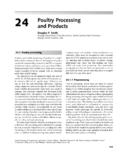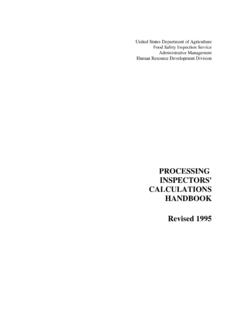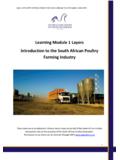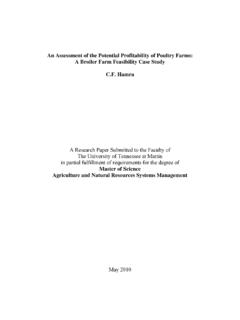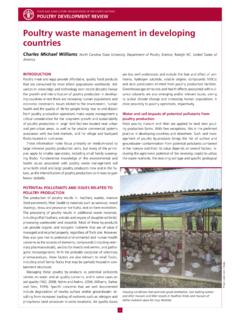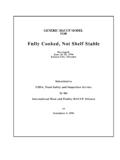Transcription of Poultry feed availability and nutrition in developing ...
1 1 FOOD AND AGRICULTURE ORGANIZATION OF THE UNITED NATIONS Poultry DeveloPment reviewPoultry feed availability and nutrition in developing countriesAlternative feedstuffs for use in Poultry feed formulationsVelmurugu Ravindran, Monogastric Research Centre, Institute of Food, nutrition and Human Health, Massey University, Palmerston North, New ZealandGlobal consumption of Poultry products, especially Poultry meat, has consistently increased over the years, and this trend is ex-pected to continue. Much of the increase in global demand for Poultry products will be in developing countries. Such growth in the Poultry industry is having a profound effect on the demand for feed and raw materials.
2 However, it is also becoming clear that the requirements for the four traditional feed ingredients maize, soybean meal, fishmeal and meat meal cannot be met, even according to optimistic forecasts. The gap between local supply and demand for these traditional ingredients is expected to widen over the coming decades, providing a compelling reason for exploring the usefulness of locally available, alternative feed -stuffs in feed formulations. A wide range of alternative feedstuffs are available for feeding in all three Poultry production systems. The greatest potential for efficiently utilizing these feedstuffs will be in traditional family Poultry systems (scavenging and backyard) and the semi-com-mercial system.
3 In the semi-commercial system, only part of the feed requirement is purchased from commercial compounders, so there is opportunity for on-farm mixing or dilution of purchased feeds with locally available, alternative feedstuffs. In low-input family Poultry systems, locally available, alternative feedstuffs can be used to supplement the scavenging feed feedstuffs the issuesAlternative feedstuffs are often referred as non-traditional feed -stuffs because they have not traditionally been used in animal feeding or are not normally used in commercial animal diets. However, it is difficult to draw a clear distinction between tradi-tional and non-traditional feeds.
4 Feedstuffs that may be classified as non-traditional in some regions, may actually be traditional and based on many years of usage in others. Some feedstuffs may have started as non-traditional, but are now being used in-creasingly in commercial diets. A good example is palm kernel meal, which is a non-traditional feedstuff in Western Africa, but an increasingly normal feedstuff for feed millers in Southeast Asia, especially in pullet and layer is widely recognized that in developing African and Asian countries, existing feed resources in many circumstances are ei-ther unutilized and wasted or used inefficiently. Most of these alternative feedstuffs have obvious potential, but their use has been negligible owing to constraints imposed by nutritional, tech-nical and socio-economic factors (Table 1).
5 Three major criteria determine the regular use of a feedstuff in commercial diets: i) it must be available in economic quantities, even if its availability is seasonal; ii) the price must be competitive against the main feed -stuffs; and iii) its nutritive value must be understood, including its nutrient content, existing variation and nutrient digestibility. In many developing countries, it may be difficult to assess the nutritive value of any feedstuff, owing to the lack or scarcity of appropriate research or analytical facilities. This is a major factor discouraging commercial feed mills from considering the use of alternative has been keen interest in evaluating alternative feed re-sources over the years, and a proliferation of published data, es-pecially from developing countries.
6 Lists of alternative feedstuffs that seem to have the greatest potential as substitutes for maize, soybean meal and animal proteins are presented in Tables 2, 3 and 4, respectively. These lists are by no means exhaustive; this in-formation note does not aim to review all the available literature on each individual ingredient, but rather to identify the general issues limiting their use and maximum inclusion levels in com-mercial Poultry diets. future ProsPects for AlterNAtive feedstuffsThe immediate prospects for the use of alternative feedstuffs listed in Tables 2, 3 and 4 will be in semi-commercial Poultry units that employ some degree of on-farm feed mixing, and family Poultry units.
7 In these sectors, where the objective is economic Nutritional aspects- Variability (or lack of consistency) in nutrient quality- Limited information on the availability of nutrients- High fibre content- Presence of anti-nutritional factor(s)- Need for nutrient supplementation (added cost) Technical aspects- Seasonal and unreliable supply - Bulkiness, physical characteristics- Need for de-hulling and/or processing (drying, detoxification)- Limited research and development facilities for determining nutrient composition and inclusion levels in Poultry dietsSocio-economic aspects- Competition with use as human food- Poor prices relative to other arable crops (farmer)- Cost per unit of energy or limiting amino acids, relative to traditional feedstuffs ( feed manufacturer)- Cost of processingTable 1 Factors limiting the use of alternative feed ingredients in Poultry feed formulations2 Poultry DeveloPment review Poultry feed availability and nutrition in developing countriesfeedstuffcommentsCerealsWheatCa n be used when cost-competitiveLimitation.
8 High non-starch polysaccharide contents result in intestinal digesta viscosity problems; can be used without restriction when exogenous carbohydrases are addedSorghumLimitation: tannins lower protein and energy digestibility; low-tannin sorghum can com-pletely replace maizeMilletsCan replace 50 65% of maize, depending on millet typeLimitations: high fibre contents, presence of tannins Cereal milling co-productsRice bran/polishingLimitations: high fibre, phytic acid, rancidity; good-quality material can be used at levels of 5 10% in broiler diets and up to 40% in layer dietsWheat bran/pollardLimitation: high fibre; can be used at levels less than 5% in broiler diets and up to 15% in layer dietsRoots and tubersCassava root mealHigh in starch, excellent energy sourceLimitations: low protein, powdery texture, needs detoxification to remove the cyano-genic glucosides; can be used at levels of 30 40% in nutritionally balanced, pelleted diets Cassava peel mealLimitations: high fibre, very high levels of cyanogenic glucosides, needs processing; carefully prepared meal may be used at 5% levelSweet potato tuber mealHigh in starch, good energy sourceLimitation: powdery texture.
9 Can be used at levels up to 50% in nutritionally balanced, pelleted dietsTa r oLimitations: poor palatability caused by calcium oxalate, needs processing; processed meal can be used at up to 10%Fruits and fruit co-productsBanana and plantain mealLimitation: low palatability due to tannins in the peel; removal of peels improves nutritive value; inclusion must be limited to 10 20%Breadfruit mealGood energy source; can be included at up to 30% Jack seed mealLimitations: lectins in raw seeds, needs processing; processed meal can be included at up to 30% Mango seed kernel mealLimitation: high levels of tannins; processed meal can be used at levels of 5 10%Date wasteLimitation: high sugar content; use must be restricted to 30% of the dietMiscellaneousSago mealLimitation: powdery texture; can be included at up to 25% Cane molassesLimitations: high sugar content, wet litter problems; use must be limited to 15% of the dietAnimal fatTallow, lard and Poultry fat; high-density energy sources that enable the use of low-energy feedstuffs in formulations; can be used at up to 5 8% Distillers dried grains with solubles (DDGS)High fat content (10%), good energy source; can be used at up to 25%feedstuffcommentsOilseed meals1 Cottonseed mealLimitations: high fibre, presence of gossypol.
10 Low-gossypol meal can be used at levels of 10 15% in broiler diets; limit use in layer diets because of effects on internal quality of eggsCanola mealLimitation: glucosinolates; low-glucosinolate meals can be used at up to 30%Groundnut mealLimitations: tannins, aflatoxin; good-quality meal can be used at up to 15%Sunflower mealLimitation: high fibre Rich in methionine; can be used at up to 15%Sesame mealLimitation: high phytate content Good source of methionine; can be used at up to 15%Palm kernel mealLimitations: high fibre, poor texture, low palatability; good-quality meal can be used at levels of 5 10% in broiler diets and up to 30% in layer dietsCopra (coconut) mealLimitations: low protein, mycotoxins; can be used at up to 20%Rubber seed mealLimitations: low protein, presence of cyano-genic glucosides, requires processing; can be used at up to 10% Grain legumes2 Lupins, field peas, chick peas, cowpeas, pigeon peas, faba beans, : presence of anti-nutrients, low in methionine; can be used at up to 20 30% when processed and supplemented with me-thionine.










